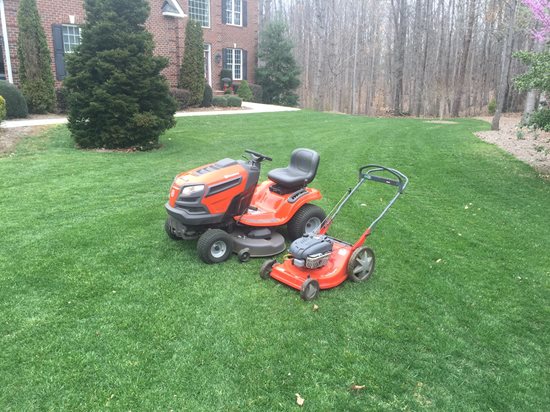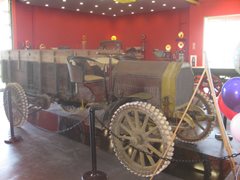 |
| The 46" cut riding mower increased my lawn mowing productivity greatly over my twenty year old 20" push mower. The increased productivity allowed for more fun activities or in some cases more profitable use of my time . |
With the spring season upon us in North Carolina, it was time this weekend to prep and mow the lawn. During the beginning of this season each year, I make sure to service the lawn equipment for the upcoming spring and summer months ahead.
As a business person, there always seems to be something on my mind in regards to business practices. During the servicing of my small 20 inch non propelled push mower, the subject of productivity entered my thoughts. I purchased this small push mower years ago and today I use a 46 inch cut, self-propelled riding mower which has greatly increased my lawn cutting productivity. In trucking, the subject of productivity has been much debated and in the headlines in various publications throughout the industry. There are many ways in which different groups seek to increase their daily production. Some seek to do this through higher weight limits, longer trailers and multiple trailers. Others seek gains from hours of service rules, increased flexibility of rules and team driver operations.
I did some research on mankind’s constant quest for increased productivity. It turns out that food procurement is an excellent illustration of recent historical advances in productivity. Years ago, most people lived in a peasant farm society which was a human, a domesticated animal and dedicated farmland responsible for food production. The peasant society lasted for thousands upon thousands of years. It only began to change approximately 300 years ago with the introduction of the Newcomen steam engine. This was the first machine made of all metal moving parts. This started a change from farm life into what has been referred to as the industrial revolution. This led to the creation of the tractor which dramatically changed society where 90% of the people were farmers or peasants to a total number of agricultural workers to about 3% of the total population. Many people moved into the cities to operate the new mechanized society. The “office worker” was created during this time to document this increased production.
 |
| The simple basket greatly improves your pine cone transport capacity over simply using your hands . |
When we take a look back at the early transportation of goods, this was limited by what an individual could carry in their arms, head or on their back. Different baskets and vessels were used to increase production in those early years. After the wheel was invented, then came carts which were later powered by domesticated animals. This quest continues today with ships, pipelines, railroads and trucks. When we look at today’s ocean vessels, they are much larger in comparison to those in the early years. Those small vessels only included a sail or humans with oars to paddle their way along. Some forms of transportation could only compete until they hit their natural barriers. For example, a horse drawn wagon could not compete with railroads, trucks or pipelines.
In more modern history, transatlantic travel was dominated by ocean going ships. In fact, the record holding cruise liner “The SS United States” sits moored in Philadelphia, PA awaiting its final fate. There was simply no way for this ship to compete with transatlantic air travel. This ship crossed the Atlantic Ocean from the New York Harbor to Bishop Rock off Cornwall, UK in 3 days, 10 hours and 40 minutes at an average speed of 35.59 knots which is 40.96 mph. The liner then broke the west bound crossing by returning to America in 3 days, 12 hours and 12 minutes at an average speed of 34.51 knots which is 39.71 mph. Thereby obtaining the eastbound and westbound speed records. The ship broke the record however could not compete with the newer airplane which could cover the distance in well under 10 hours.
 |
| Our productivity is much greater than this truck from long ago . |
Today, the trucking industry has advanced a long way from its early years. The innovation of the fifth wheel hitch added to a Ford Model T Truck dramatically enhanced its production levels. Early weight limits were as low as 18,000 lbs. per truck which quickly grew to a limit of 73,280 lbs. in 1956 which became the standard until 1974 and then increased to 80,000 lbs.
Today there is pressure to once again increase our lengths and weight limits to better compete in the marketplace. There are many who would like to keep things just as they are and others who are still embracing mankind’s quest for increased yields. Our main competitors for continental transport are railroads and air transport. Both of these are constantly advancing in areas of capacity and productivity. I’m not too sure if they can compete locally however they can reach us on productivity and efficiency on long haul transport. The airplane has an advantage in regards to speed. Pipelines can beat us on sheer volume however not all material can be transported through a pipe. Railroads on the other hand are quickly abandoning the traditional box car and adopting the intermodal container as their shipping vessel of choice . The railroads have not stopped at just hauling the containers as they have improved their productivity by double stacking and streamlining right of ways .
 |
| The proud record holding SS United States sitting in Philadephia, PA . Photo credit www.ssusc.org |
When it comes to transportation, we must continue to develop new innovation and technologies in order to advance into the future. If not, we run the risk of being a footnote in history like the “SS United States” sitting moored in a lonely dock in Philadelphia, PA.